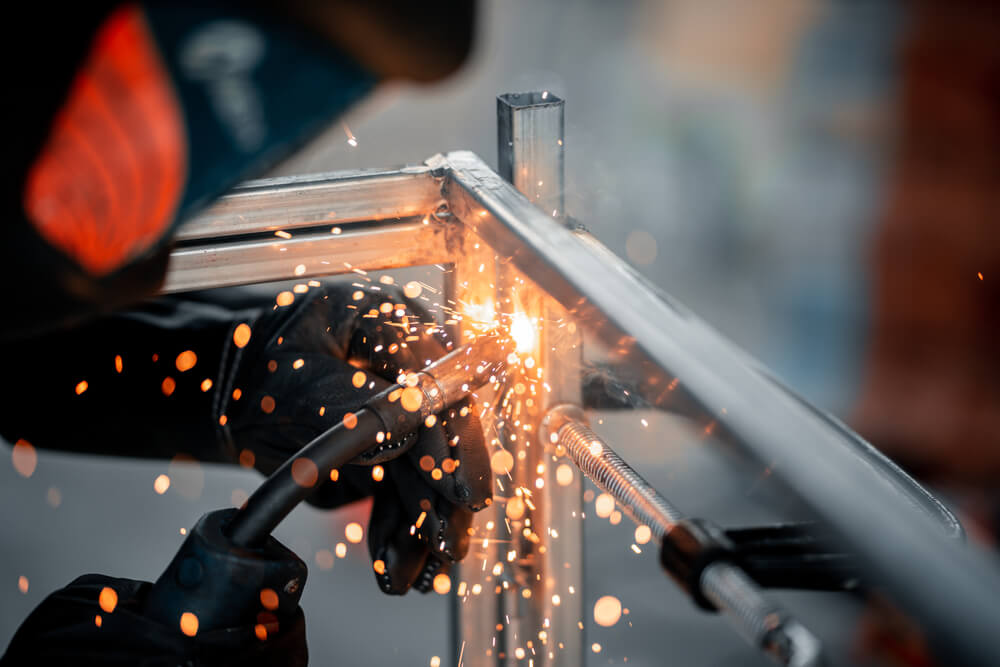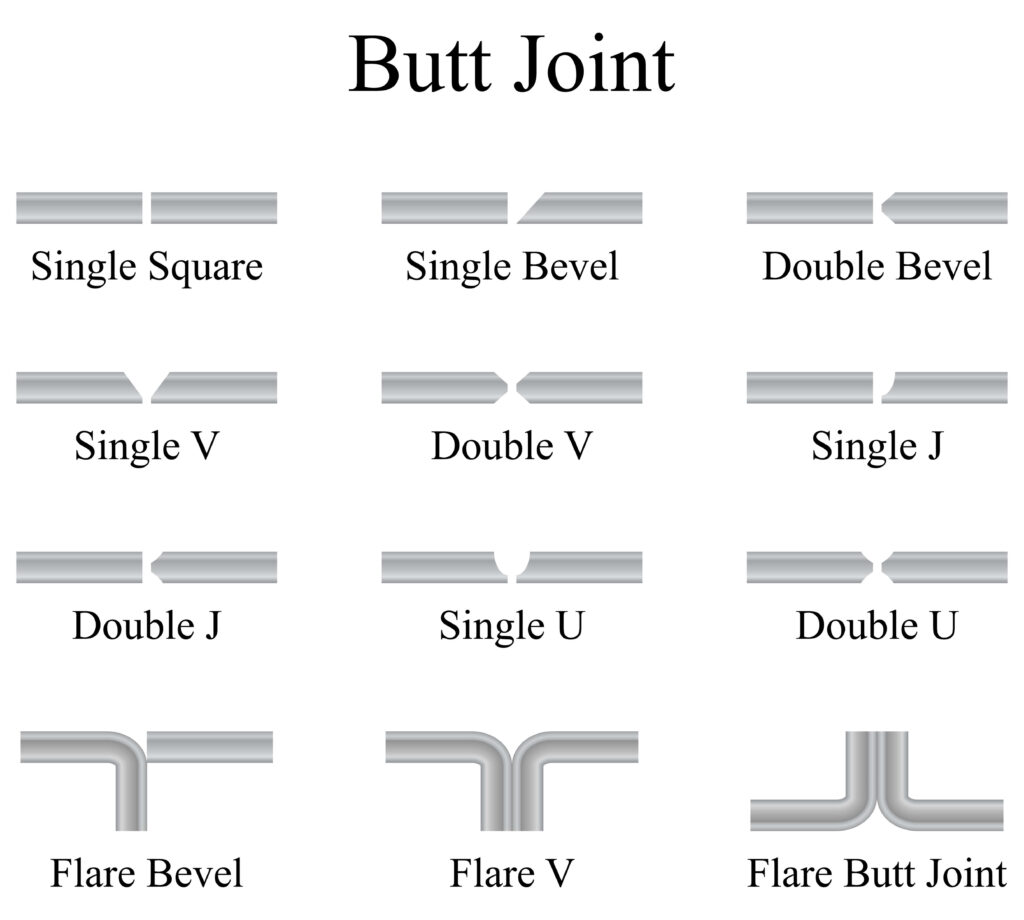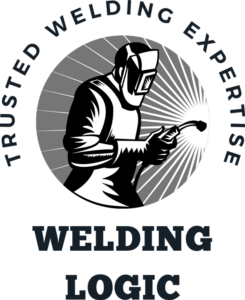The edge joint is an outstanding weld that enables you to build metal structures. It also can add strength to an object by reinforcing metal with another layer of metal.
There are several types of edge joints and different ways to create them. All of them work very well for building and reinforcing metal structures.
In This Article
Common Uses for Edge Joints
The edge joint refers to where the edges of two pieces of metal are welded together. they always join together two pieces of metal that rest up against one another.
Sometimes there is a narrow gap between the two pieces of metal, but they always are joined at their edges.
The edge joint weld commonly is used to:
- Weld sheet metal
- Reinforce the flanges when welding plates
- Join square pipes and angled metals
- Weld mufflers
The metals always are flush when welding them. The nature of the edge joint weld makes it especially good for thin plate metals and sheet metal.
Three Types of Edge Joints
The types of edge joints cover virtually all of the weld’s applications. They help to add structural rigidity to objects made of thin metals, such as the muffler on your vehicle.
The three types of edge joint welds are:
- Edge weld on an edge joint
- Edge weld on a flanged butt joint
- Edge weld on a corner flange joint
The edge weld on an edge joint generally welds together to flat pieces of metal.
The edge weld on a flange butt joint connects the flat portions of two flanged pieces of metal. So there are two flanged pieces that are joined at their respective edges.
The edge weld on a corner flange joint joins a flat piece of metal with a flanged piece at its respective edges.
You do not weld both sides of the metal when you use edge joints. The weld only goes on one side, which makes it weaker but still sufficient for thin metals.
Why the Edge Joint Works Well With Thin Metals
The edge joints are especially useful with sheet metal and thin plate metals due to their pliability.
It is very easy to create a flange on one or two pieces of thin metal and join them at a flush edge.
Instead of heating the edge of one to the face of another piece of thin metal, the edges take the heat. It is a lot easier to flatten and straighten the edge joint on sheet metal and thin plates than with thicker metals.
The edge weld also helps to keep the heat again from the flat and open area of an object where the thin metal would be more prone to warping.
A different type of weld also would make it a lot easier to overly penetrate the thin metal and damage it beyond repair.
The edge joint weld also works well with light metals, such as aluminum, that do not hold up so well to high heat.
Equipment Used for Edge Joint Welds
The combination of thin metal and running the weld along their respective edges makes oxy-acetylene ideal for laying edge joint welds.
You can keep the heat focused on the very edges of the metals and just add some filler with a thin rod.
Edge joint welds also work very well with MIG and TIG welding.
MIG works well with thicker pieces of sheet metal that still are thinner than arc welding would require. The wire welder can precisely feed a very thin wire that keeps the welding heat concentrated to where you are laying it.
When you are welding aluminum or other lighter metals that are prone to warping and heat deformation, TIG welding can do a great job with edge joint welds.
You also can create edge joint welds with an arc welding setup. The metal should be much thicker than sheet metal and might require some beveling or grooving to enable better penetration and a stronger weld.
How to Lay an Edge Joint Weld
You should prepare for laying an edge joint weld by cleaning the metal to remove any oil, grease, metal coating, or other contaminants that might cause a bad weld.
You might have to bevel one or both edges to create a groove that is similar to a V-groove or a bevel groove.
Once your metal pieces are cleaned and formed properly, you should clamp them together. Clamping them will help eliminate any tiny gaps between the two metals so that you can lay a much better and more effective weld along the edge.
You can tack either end of the edge weld and at intervals along its length. That will help to keep the metal together more tightly while you lay the final weld.
When you lay the weld, the filler should cover both edges. The finished weld should be equal to the combined width of the two pieces of metal. The bead should cover both edges by running over either side.
Edge Joint Weld Symbol & Callout Explained
A welding diagram will use basic symbols on the reference line with an arrow pointing to where the edge joint weld goes. The diagram will tell you the width of the weld and the depth if it requires beveling.
The diagram will illustrate the type of edge joint that you need to complete correctly.
The most commonly used is the edge weld on an edge joint which is indicated by two rectangles situated side by side.
Less frequent is the edge weld on a flanged butt joint, which will show two flanged pieces joined at one edge.
Also less frequent is the edge weld on a corner flanged joint, which is indicated by a flat piece or a rectangle situated with a curved or flanged piece of metal adjacent to it.
The edge joint callout is used to indicate the location, type, and size of an edge joint on a drawing.
Inspecting an Edge Joint Weld
You can clean the edge joint weld with a chipping hammer and a wire brush or wheel to clean off any flux, slag, or residue. You also might grind it level to make it smooth and give you a better look at the condition of the weld.
You should check for uniformity and any potential defects. If you find any problems, you can remove the weld with a grinder and lay a new bead in its place.
Mig Welding for Edge Joints
Here is a great video overview of Mig welding for edge joints:
Frequently Asked Questions
Additional Sources & Resources
-https://www.ndt-ed.org/EducationResources/HighSchool/ Welding/buttjoints.htm
-https://books.google.com/books?id=2VgqDwAAQBAJ&pg=PA395&lpg=PA395&dq=edge+joint+welding&source=bl&ots=nCWfUHIk4m&sig=ACfU3U1cRuI6zkyffoNhcvrP8-7rLKcnYw&hl=en&sa=X&ved=2ahUKEwiV6-WQ8J_qAhXFbs0KHaDpBbgQ6AEwAnoECAgQAQ#v=onepage&q=edge%20joint%20welding&f=false
-https://www.sciencedirect.com/topics/materials-science/butt-joint
-https://www.migwelders.co.uk/types-of-joints-for-mig-welding/


